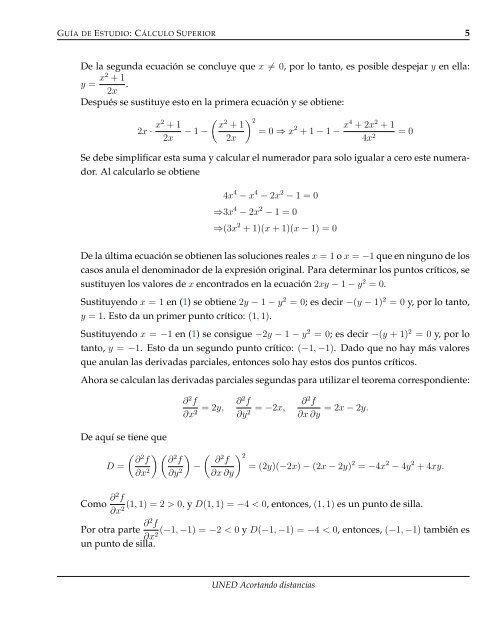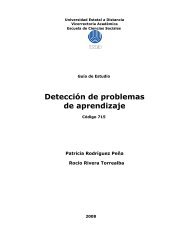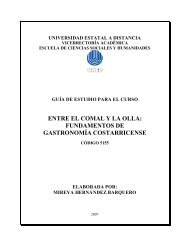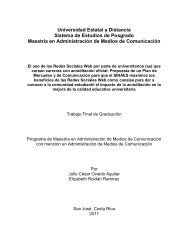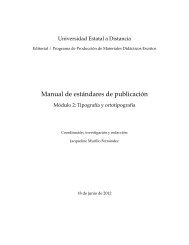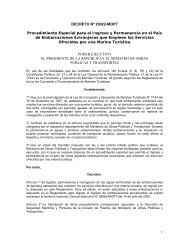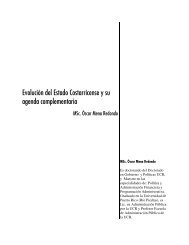GE3011 Cálculo Superior - Repositorio de la Universidad Estatal a ...
GE3011 Cálculo Superior - Repositorio de la Universidad Estatal a ...
GE3011 Cálculo Superior - Repositorio de la Universidad Estatal a ...
You also want an ePaper? Increase the reach of your titles
YUMPU automatically turns print PDFs into web optimized ePapers that Google loves.
GUÍA DE ESTUDIO: CÁLCULO SUPERIOR 5<br />
De <strong>la</strong> segunda ecuación se concluye que x = 0, por lo tanto, es posible <strong>de</strong>spejar y en el<strong>la</strong>:<br />
y = x2 + 1<br />
2x .<br />
Después se sustituye esto en <strong>la</strong> primera ecuación y se obtiene:<br />
2x · x2 + 1<br />
2x<br />
2 x + 1<br />
− 1 −<br />
2x<br />
2<br />
= 0 ⇒ x 2 + 1 − 1 − x4 + 2x 2 + 1<br />
4x 2<br />
Se <strong>de</strong>be simplificar esta suma y calcu<strong>la</strong>r el numerador para solo igua<strong>la</strong>r a cero este numera-<br />
dor. Al calcu<strong>la</strong>rlo se obtiene<br />
4x 4 − x 4 − 2x 2 − 1 = 0<br />
⇒3x 4 − 2x 2 − 1 = 0<br />
⇒(3x 2 + 1)(x + 1)(x − 1) = 0<br />
De <strong>la</strong> última ecuación se obtienen <strong>la</strong>s soluciones reales x = 1 o x = −1 que en ninguno <strong>de</strong> los<br />
casos anu<strong>la</strong> el <strong>de</strong>nominador <strong>de</strong> <strong>la</strong> expresión original. Para <strong>de</strong>terminar los puntos críticos, se<br />
sustituyen los valores <strong>de</strong> x encontrados en <strong>la</strong> ecuación 2xy − 1 − y 2 = 0.<br />
Sustituyendo x = 1 en (1) se obtiene 2y − 1 − y 2 = 0; es <strong>de</strong>cir −(y − 1) 2 = 0 y, por lo tanto,<br />
y = 1. Esto da un primer punto crítico: (1, 1).<br />
Sustituyendo x = −1 en (1) se consigue −2y − 1 − y 2 = 0; es <strong>de</strong>cir −(y + 1) 2 = 0 y, por lo<br />
tanto, y = −1. Esto da un segundo punto crítico: (−1, −1). Dado que no hay más valores<br />
que anu<strong>la</strong>n <strong>la</strong>s <strong>de</strong>rivadas parciales, entonces solo hay estos dos puntos críticos.<br />
Ahora se calcu<strong>la</strong>n <strong>la</strong>s <strong>de</strong>rivadas parciales segundas para utilizar el teorema correspondiente:<br />
De aquí se tiene que<br />
<br />
2 2 ∂ f ∂ f<br />
D =<br />
−<br />
∂x 2<br />
∂y 2<br />
∂2f = 2y,<br />
∂x2 ∂2f = −2x,<br />
∂y2 ∂ 2 f<br />
∂x ∂y<br />
= 2x − 2y.<br />
= 0<br />
2 2<br />
∂ f<br />
= (2y)(−2x) − (2x − 2y)<br />
∂x ∂y<br />
2 = −4x 2 − 4y 2 + 4xy.<br />
Como ∂2f (1, 1) = 2 > 0, y D(1, 1) = −4 < 0, entonces, (1, 1) es un punto <strong>de</strong> sil<strong>la</strong>.<br />
∂x2 Por otra parte ∂2f (−1, −1) = −2 < 0 y D(−1, −1) = −4 < 0, entonces, (−1, −1) también es<br />
∂x2 un punto <strong>de</strong> sil<strong>la</strong>.<br />
UNED Acortando distancias


